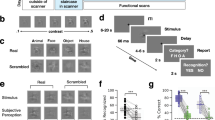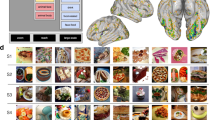Abstract
Human behavioral studies show that there is greater sensory/perceptual detail associated with true memories than false memories. We therefore hypothesized that true recognition of abstract shapes would elicit greater visual cortical activation than would false recognition. During functional magnetic resonance imaging (fMRI), participants studied exemplar shapes and later made recognition memory decisions (“old” or “new”) concerning studied exemplars (old shapes), nonstudied lures (related shapes) and new shapes. Within visual processing regions, direct contrasts between true recognition (“old” response to an old shape; old-hit) and false recognition (“old” response to a related shape; related-false alarm) revealed preferential true recognition–related activity in early visual processing regions (Brodmann area (BA)17, BA18). By comparison, both true and false recognition were associated with activity in early and late (BA19, BA37) visual processing regions, the late regions potentially supporting “old” responses, independent of accuracy. Further analyses suggested that the differential early visual processing activity reflected repetition priming, a type of implicit memory. Thus, the sensory signature that distinguishes true from false recognition may not be accessible to conscious awareness.
This is a preview of subscription content, access via your institution
Access options
Subscribe to this journal
Receive 12 print issues and online access
$209.00 per year
only $17.42 per issue
Buy this article
- Purchase on Springer Link
- Instant access to full article PDF
Prices may be subject to local taxes which are calculated during checkout





Similar content being viewed by others
References
Schacter, D.L. The seven sins of memory. Insights from psychology and cognitive neuroscience. Am. Psychol. 54, 182–203 (1999).
Roediger, H.L. Memory illusions. J. Mem. Lang. 35, 76–100 (1996).
Bartlett, F.C. Remembering: A Study in Experimental and Social Psychology (Cambridge Univ. Press, London, 1932).
Underwood, B.J. False recognition produced by implicit verbal responses. J. Exp. Psychol. 70, 122–129 (1965).
Roediger, H.L. & McDermott, K.B. Creating false memories: remembering words not presented in lists. J. Exp. Psychol. Learn. Mem. Cogn. 21, 803–814 (1995).
Deese, J. On the prediction of occurrence of particular verbal intrusions in immediate recall. J. Exp. Psychol. 58, 17–22 (1959).
Koutstaal, W., Schacter, D.L., Verfaellie, M., Brenner, C. & Jackson, E.M. Perceptually based false recognition of novel objects in amnesia: effects of category size and similarity to category prototypes. Cogn. Neuropsychol. 16, 317–341 (1999).
Schooler, J.W., Gerhard, D. & Loftus, E.F. Qualities of the unreal. J. Exp. Psychol. Learn. Mem. Cogn. 12, 171–181 (1986).
Mather, M., Henkel, L.A. & Johnson, M.K. Evaluating characteristics of false memories: remember/know judgments and memory characteristics questionnaire compared. Mem. Cogn. 25, 826–837 (1997).
Norman, K.A. & Schacter, D.L. False recognition in younger and older adults: exploring the characteristics of illusory memories. Mem. Cogn. 25, 838–848 (1997).
Schacter, D.L. et al. Neuroanatomical correlates of veridical and illusory recognition memory: evidence from positron emission tomography. Neuron 17, 267–274 (1996).
Schacter, D.L., Buckner, R.L., Koutstaal, W., Dale, A.M. & Rosen, B.R. Late onset of anterior prefrontal activity during true and false recognition: an event-related fMRI study. Neuroimage 6, 259–269 (1997).
Cabeza, R., Rao, S.M., Wagner, A.D., Mayer, A.R. & Schacter, D.L. Can medial temporal lobe regions distinguish true from false? An event-related functional MRI study of veridical and illusory recognition memory. Proc. Natl. Acad. Sci. USA 98, 4805–4810 (2001).
Buckner, R.L., Koutstaal, W., Schacter, D.L., Wagner, A.D. & Rosen, B.R. Functional-anatomic study of episodic retrieval using fMRI. Neuroimage 7, 151–162 (1998).
Lepage, M., Ghaffar, O., Nyberg, L. & Tulving, E. Prefrontal cortex and episodic memory retrieval mode. Proc. Natl. Acad. Sci. USA 97, 506–511 (2000).
Slotnick, S.D., Moo, L.R., Segal, J.B. & Hart, J. Distinct prefrontal cortex activity associated with item memory and source memory for visual shapes. Cogn. Brain Res. 17, 75–82 (2003).
Wheeler, M.E. & Buckner, R.L. Functional dissociation among components of remembering: control, perceived oldness, and content. J. Neurosci. 23, 3869–3880 (2003).
Bar, M. & Aminoff, E. Cortical analysis of visual context. Neuron 38, 347–358 (2003).
Nyberg, L. et al. Reactivation of motor brain areas during explicit memory for actions. Neuroimage 14, 521–528 (2001).
Nyberg, L., Habib, R., McIntosh, A.R. & Tulving, E. Reactivation of encoding-related brain activity during memory retrieval. Proc. Natl. Acad. Sci. USA 97, 11120–11124 (2000).
Wheeler, M.E., Petersen, S.E. & Buckner, R.L. Memory's echo: vivid remembering reactivates sensory-specific cortex. Proc. Natl. Acad. Sci. USA 97, 11125–11129 (2000).
Vaidya, C.J., Zhao, M., Desmond, J.E. & Gabrieli, J.D.E. Evidence for cortical encoding specificity in episodic memory: memory-induced re-activation of picture processing areas. Neuropsychologia 40, 2136–2143 (2002).
Wheeler, M.E. & Buckner, R.L. Functional-anatomic correlates of remembering and knowing. Neuroimage 21, 1337–1349 (2004).
Tulving, E. & Schacter, D.L. Priming and human memory systems. Science 247, 301–306 (1990).
Rugg, M.D. et al. Dissociation of the neural correlates of implicit and explicit memory. Nature 392, 595–598 (1998).
Henson, R.N.A., Shallice, T., Gorno-Tempini, M.L. & Dolan, R.J. Face repetition effects in implicit and explicit memory tests as measured by fMRI. Cereb. Cortex 12, 178–186 (2002).
Tulving, E., Kapur, S., Craik, F.I.M., Moscovitch, M. & Houle, S. Hemispheric encoding/retrieval asymmetry in episodic memory: positron emission tomography findings. Proc. Natl. Acad. Sci. USA 91, 2016–2020 (1994).
Buckner, R.L. Beyond HERA: contributions of specific prefrontal brain areas to long-term memory retrieval. Psychon. Bull. Rev. 3, 149–158 (1996).
Wagner, A.D., Maril, A., Bjork, R.A. & Schacter, D.L. Prefrontal contributions to executive control: fMRI evidence for functional distinctions within lateral prefrontal cortex. Neuroimage 14, 1337–1347 (2001).
Haxby, J.V. et al. Face encoding and recognition in the human brain. Proc. Natl. Acad. Sci. USA 93, 922–927 (1996).
Henson, R.N.A., Rugg, M.D., Shallice, T. & Dolan, R.J. Confidence in recognition memory for words: dissociating right prefrontal roles in episodic retrieval. J. Cogn. Neurosci. 12, 913–923 (2000).
Donaldson, D.I., Petersen, S.E. & Buckner, R.L. Dissociating memory retrieval processes using fMRI: evidence that priming does not support recognition memory. Neuron 31, 1047–1059 (2001).
Rugg, M.D., Henson, R.N.A. & Robb, W.G.K. Neural correlates of retrieval processing in the prefrontal cortex during recognition and exclusion tasks. Neuropsychologia 41, 40–52 (2003).
Velanova, K. et al. Functional-anatomic correlates of sustained and transient processing components engaged during controlled retrieval. J. Neurosci. 23, 8460–8470 (2003).
Buckner, R.L., Raichle, M.E., Miezin, F.M. & Petersen, S.E. Functional anatomic studies of memory retrieval for auditory words. J. Neurosci. 16, 6219–6235 (1996).
Konishi, S., Wheeler, M.E., Donaldson, D.I. & Buckner, R.L. Neural correlates of episodic retrieval success. Neuroimage 12, 276–286 (2000).
Price, C.J. The anatomy of language: contributions from functional neuroimaging. J. Anat. 197, 335–359 (2000).
Walla, P., Endl, W., Lindinger, G., Deecke, L. & Lang, W. Implicit memory within a word recognition task: an event-related potential study in human subjects. Neurosci. Lett. 269, 129–132 (1999).
Buckner, R.L. et al. Functional anatomic studies of explicit and implicit memory retrieval tasks. J. Neurosci. 15, 12–29 (1995).
Buckner, R.L. et al. Functional-anatomic correlates of object priming in humans revealed by rapid presentation event-related fMRI. Neuron 20, 285–296 (1998).
Squire, L.R. et al. Activation of the hippocampus in normal humans: a functional anatomical study of memory. Proc. Natl. Acad. Sci. USA 89, 1837–1841 (1992).
Schacter, D.L. & Buckner, R.L. Priming and the brain. Neuron 20, 185–195 (1998).
Wiggs, C.L. & Martin, A. Properties and mechanisms of perceptual priming. Curr. Opin. Neurobiol. 8, 227–233 (1998).
Dobbins, I.G., Schnyer, D.M., Verfaellie, M. & Schacter, D.L. Cortical activity reductions during repetition priming can result from rapid response learning. Nature 428, 316–319 (2004).
Henson, R., Shallice, T. & Dolan, R. Neuroimaging evidence for dissociable forms of repetition priming. Science 287, 1269–1272 (2000).
Schacter, D.L. et al. Brain regions associated with retrieval of structurally coherent visual information. Nature 376, 587–590 (1995).
Uecker, A. et al. Neuroanatomical correlates of implicit and explicit memory for structurally possible and impossible visual objects. Learn. Mem. 4, 337–355 (1997).
Fisher, R.A. Statistical Methods for Research Workers. edn. 14 (Hafner, New York, 1973).
Schacter, D.L., Israel, L. & Racine, C. Suppressing false recognition in younger and older adults: the distinctiveness heuristic. J. Mem. Lang. 40, 1–24 (1999).
Dodson, C.S. & Schacter, D.L. Aging and strategic retrieval processes: reducing false memories with a distinctiveness heuristic. Psychol. Aging 17, 405–415 (2002).
Acknowledgements
We thank L. Moo for helpful discussions and use of her BrainVoyager software. This work was supported by grants MH-NS60941 from the National Institute of Mental Health and AG08441 from the National Institute on Aging.
Author information
Authors and Affiliations
Corresponding author
Ethics declarations
Competing interests
The authors declare no competing financial interests.
Supplementary information
Rights and permissions
About this article
Cite this article
Slotnick, S., Schacter, D. A sensory signature that distinguishes true from false memories. Nat Neurosci 7, 664–672 (2004). https://doi.org/10.1038/nn1252
Received:
Accepted:
Published:
Issue Date:
DOI: https://doi.org/10.1038/nn1252
This article is cited by
-
Development of performance and learning rate evaluation models in robot-assisted surgery using electroencephalography and eye-tracking
npj Science of Learning (2024)
-
Dynamics of working memory process revealed by independent component analysis in an fMRI study
Scientific Reports (2023)
-
Representation of shared surface information and false memory for abstract versus concrete pictures in the conjoint recognition paradigm
Psychological Research (2023)
-
Neural spatio-temporal patterns of information processing related to cognitive conflict and correct or false recognitions
Scientific Reports (2022)
-
Task-dependent fractal patterns of information processing in working memory
Scientific Reports (2022)



